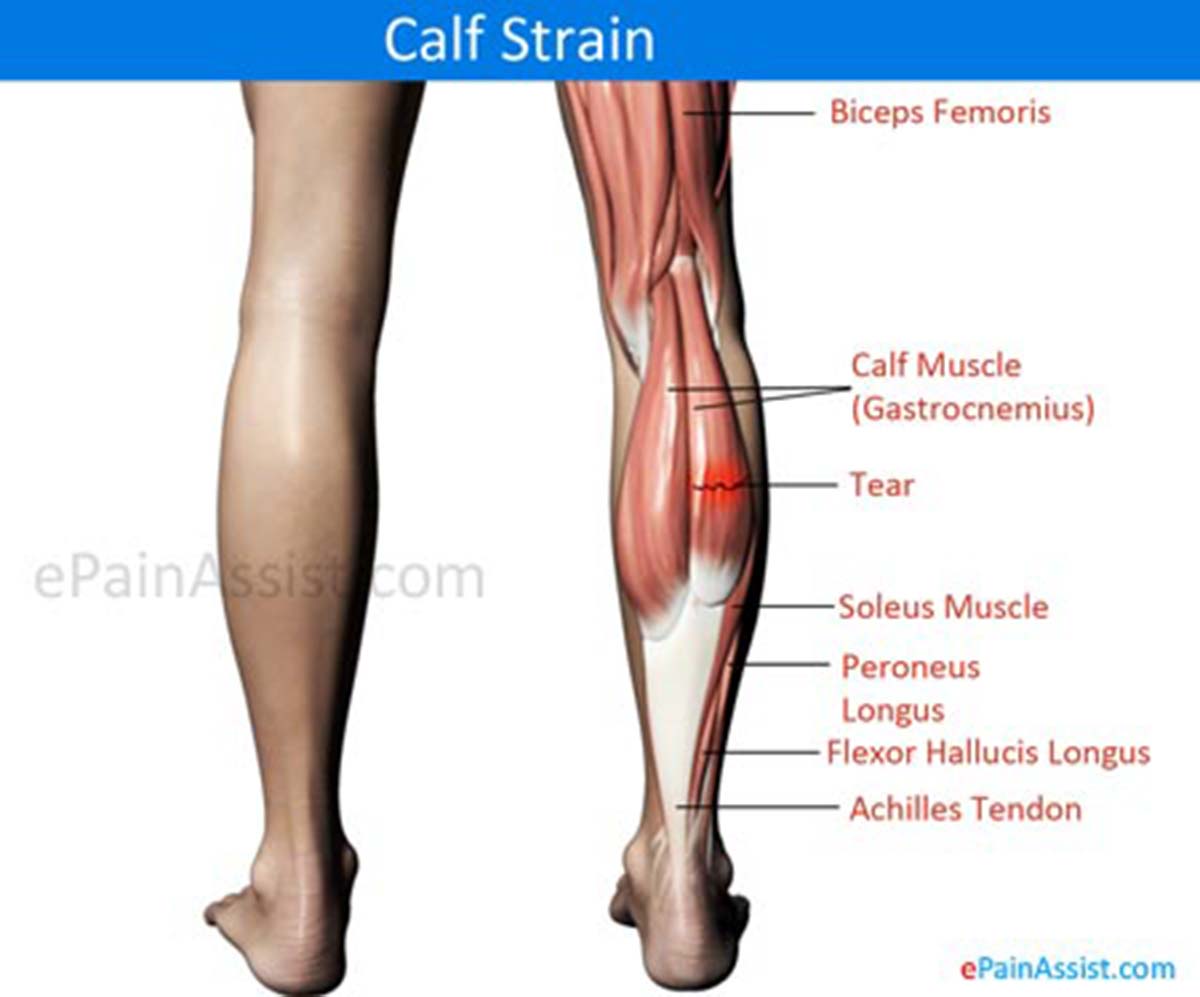The calf muscles are located at the back part of the leg. They extend the distance from the knee to the ankle. The calf muscle comprises of three major muscles, two gastrocnemius muscles, and the soleus muscle.
Muscle strains are caused when the particular muscle is stretched too far causing it injury. The strain can be less in severity or major in severity. When the muscle is pulled just beyond its normal excursion, it results in a less severe strain. When the muscle fibers are torn partially or completely, it results in a more severe strain. However, commonly, the less severe strains are found.
Calf strain occurs when the gastrocnemius muscle is stretched too far.

Causes of Calf Strain
Calf strain[¹] results from too much stretching or tearing of any of the calf muscles causing pain and swelling. Your calf muscles are located at the back of your leg. Calf strains are often associated with playing sports where the calf muscles are forcefully shortened. The condition can also be caused by an overuse or repetitive injury. A calf strain is also called pulled calf.
Examples Of Sports Activities At Risk For Calf Strain Include
- Track and field sports (Sprinting/Long Jump /Hurdles)
- Racquet Sports (Tennis/Badminton)
- Football
- Basketball
- Soccer
- Rugby
Other causes of calf strains[²] may include calf tightness, fatigue, overexertion and not stretching before a sports activity.
People who have had calf strains are at risk of future calf injuries.

Symptoms Of Calf Strain
Depending On The Severity of The Injury, Calf Strains Are Usually Graded As Follows:
- Grade I Calf Strain: Mild discomfort, often minimal disability. Usually minimal or no limits to activity.
- Grade II Calf Strain: Moderate discomfort with walking, and limited ability to perform activities, such as running and jumping; may have swelling and bruising associated.
- Grade III Calf Strain: Severe injury that can cause inability to walk. Often patients complain of muscle spasm, swelling and significant bruising.
- Calf strains commonly occur in men aged between 30 and 50. Those effected notice a sudden, sharp pain in the back of the leg. Most commonly the medical gastrocnemius muscle is caused injury. This muscle is on the inner side of the back of the leg. The injury usually occurs just above the midpoint of the leg (between the knee and ankle). This area of the calf becomes tender and swollen when a muscle strain occurs.
Treatment of Calf Strain[3]
Depending on the severity of the injury, the treatment is guided. Rest can be considered the most important key in successfully treating the pulled calf muscle. Activities that do not aggravate the injury should be performed by the individual. You should rest until you are pain free to allow the injured muscle to heal. Inadequate rest may prolong the recovery.
The Following Are The Common Treatments Used For Calf Strain
- Rest–It is important to rest following the injury to allow the injured muscle to properly heal. Allow pain to guide your level of activity; this means that activities that cause symptoms should be avoided.
- Stretching–Gentle stretching is helpful, but it should not be painful. Stretching excessively can be harmful and slow the healing process. There are some simple calf stretches that can help you along your rehab.
- Ice the Injury–Apply ice to the injured area in the acute phase (first 48 hours after injury) and then after activities. Ice will help calm the inflammatory response and stimulate blood flow to the area.
- Heat Applications–Before activities, gentle heating can help loosen the muscle. Apply a heat pack to the calf prior to stretching or exercising. As a general rule of thumb, remember to heat the area before and ice after; learn to know when to ice and when to heat an injury.
- Anti-inflammatory Medications–Oral anti-inflammatory medications can help relieve the symptoms of pain and also calm the inflammation.
Physical Therapy (PT) for Calf Strain
Physical therapists can be helpful in guiding the treatment that may speed your recovery. Some people find modalities, such as ultrasound, therapeutic massage and specific exercises, particularly helpful. You should see your physician to determine if these would be appropriate for your condition.
Prognosis and Recovery time following Calf Strain
Grade 1 Calf strain is often caused by muscle spasm and minor muscle injury. The recovery time for grade 1 calf muscle strain is often 7 to 10 days. Prognosis[⁴] is excellent for complete recovery. Grade 2 injury may be caused by partial muscle tear or tendon inflammation, which takes about 1 to 3 weeks for complete recovery. In few cases recovery period is prolonged when injury causes multiple calf muscle partial tear. Recovery period for grade 2 calf muscle strain is prolonged because of muscle weakness following the healing of partial tear. The muscle weakness is treated with physical therapy. The time required for complete recovery and normal function is 3 to 6 weeks. Grade 3 injuries are mostly associated with complete tear of calf muscle or tendon. Patient may need 6 to 8 weeks for complete healing of muscle or tendon tear in case of grade 3 calf muscle strain. The calf muscle activities are restricted for 4 to 6 weeks by applying braces or cast to prevent calf muscle contraction. The application of prolonged braces or cast causes muscle weakness and patient needs to follow up with physical therapy to gain the muscle strength. Overall patient needs 8 to 12 weeks to recover from muscle tear and weakness. Prognosis is excellent with all types of calf injures.
- https://www.betterhealth.vic.gov.au/health/ConditionsAndTreatments/sprains-and-strains
- https://www.healthdirect.gov.au/calf-pain#:~:text=Calf%20pain%20is%20usually%20caused,away%20quite%20quickly%20by%20themselves.
- https://www.ncbi.nlm.nih.gov/pmc/articles/PMC3845475/
- https://medlineplus.gov/ency/article/002116.html
Also Read:
